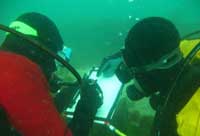
Photo: BOURNEMOUTH UNIVERSITY
An unidentified wreck, believed to be 400 years old, has been described as the “biggest discovery since the Mary Rose.” For centuries, it was covered by sand but is now rotting away so fast that it may effectively disappear within five years.
Battle to save remains of 400-year-old wreck
The remains of the ship, known simply as the Swash Channel Wreck, were preserved for centuries under the seabed in six metres of water off the Dorset coast. But now its ornately carved timbers, the earliest still in existence in Britain, are literally being eaten away.
The sand that protected it has been shifted by changing currents and tides, leaving the 40m vessel’s timbers exposed to bacteria and the tunnelling of aquatic shipworms. Tests on the timbers and artefacts trace the ship’s history back to Europe in the early 1600s, where it was probably engaged in the beginnings of international trade with the Far East.
A Bournemouth University marine archaeology team has been studying the wreck since 2006. But they are now so concerned at its deterioration that they have decided to raise and preserve part of the hull next month .
David Payton, senior lecturer in marine archaeology at the university, said: “The damage there has increased dramatically since we first started studying it. It’s a race – you’ve only got a certain amount of time before it’s too late and there’s no point
“It’s been buried until now, but in the last four or five years it’s become exposed. The longer the wreck is exposed, the more damaged it will be. If nothing were done within the next five years there’d be nothing left.”
The easiest and most effective way to preserve the ship would be to rebury it, but this is not an option for the whole vessel, as it would create a hump on the seabed in a crucial shipping channel. Instead, scientists plan to pull out those sections of the ship that would be in the way and rebury the rest.
Thanks to Irwin Bryan for the passing the article along.
